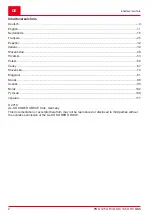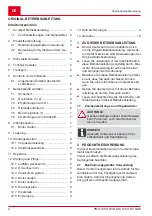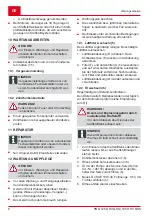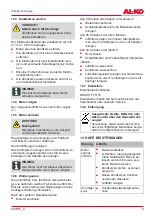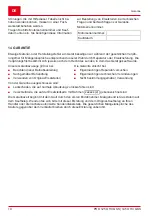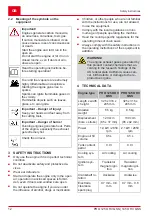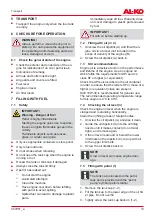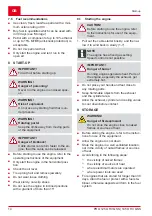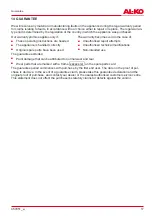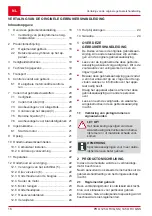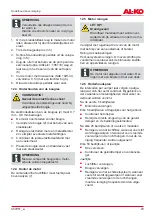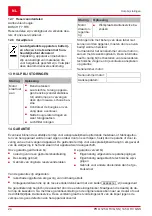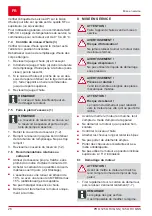
457951_a
13
Transport
5
TRANSPORT
■
Transport the engine only when the fuel tank
is empty.
6
CHECKS BEFORE OPERATION
WARNING!
Always perform a visual check prior to
start-up. Do not operate the equipment if
the operating and/or fastening parts are
loose, damaged, or worn.
6.1
Check the general state of the engine
■
Check the exterior and underside of the en-
gine for indications of an oil or petrol leak.
■
Indications of damage
■
All nuts and bolts must be tight.
■
All guards and covers are fitted.
■
Fuel level
■
Engine oil level
■
Air filter insert
7
FILLING WITH FUEL
7.1
Safety
IMPORTANT!
Warning - Danger of fire!
Petrol is highly inflammable.
Starting the engine gives rise to sparks;
these can ignite flammable gases in the
vicinity.
Flammable objects such as leaves,
grass, or similar can ignite.
■
Only use appropriate containers to store petrol
■
Only refuel outdoors
■
Do not smoke when refuelling
■
Do not open the tank cap when the engine is
running or hot
■
Renew the tank or tank cap if damaged
■
Always close the tank lid firmly
■
If petrol has leaked out:
■
Do not start the engine
■
Avoid start attempts
■
Clean the machine
■
Have engine cool down before refilling
with petrol to avoid spilling.
■
Spilled fuel can lead to damage to plastic
parts.
Immediately wipe off fuel. Warranty does
not cover damage to plastic parts caused
by fuel
IMPORTANT!
Fill with oil before starting up.
7.2
Filling with oil (3 / 4)
1. Unscrew the oil dipstick (A) and fill with en-
gine oil via a funnel (not included in the
scope of delivery of the engine) (B).
2. Screw the oil dipstick (A) back in.
7.3
Oil recommendations
Engine oil is a decisive factor on the performance
and lifetime of the engine. Use an engine oil
which fulfils the requirements for API service
class SF or higher (or equivalent).
Check the API service label on the oil container
in order to ensure that the letters SF or those of a
higher (or equivalent) class are present.
SAE 10W-30 is recommended for general use.
The recommended operating temperature range
for this engine is 0°C to 40°C.
7.4
Checking the oil level (3)
Check the engine oil level when the engine is
stopped and is standing horizontally.
Clean the oil filling areas of foreign bodies.
1. Unscrew the oil dipstick (A), and wipe it clean.
2. Guide the oil dipstick (A) into the oil filling
nozzle until it makes contact (do not twist
tight), and remove again.
3. If the oil level is around or below the lower
limit mark on the dipstick (C), top up with oil
to the upper limit mark.
4. Screw the oil dipstick back in.
NOTE
A low oil level can cause engine dam-
age.
7.5
Filling with petrol (1)
NOTE
The tank cap is located on the petrol
tank and is provided with the “petrol
pump” symbol (petrol station).
1. Remove the tank cap (1-2).
2. Fill the tank up to the lower edge of the oil fill-
er pipe. Do not overfill.
3. Tightly screw the tank cap back on (1-2).
Summary of Contents for PRO 125 OHV QSS
Page 3: ...457951_a 3...
Page 113: ...457951_a 113 15 8 1 1 1 7 9 30 10 1 5 10 1 10 2...
Page 115: ...457951_a 115 3 4 12 4 7 12 5 12 6 5 5 25 3 50 12 7 BOSCH F7 RTC 12 8 13...
Page 116: ...RU 116 PRO 125 OHV QSS 145 OHV QSS 14 xxxxxx x...
Page 121: ...457951_a 121 9 30 10 1 5 10 1 10 2 11 AL KO 12...
Page 123: ...457951_a 123 25 3 50 12 7 BOSCH F7 RTC 12 8 13 14 xxxxxx x...


